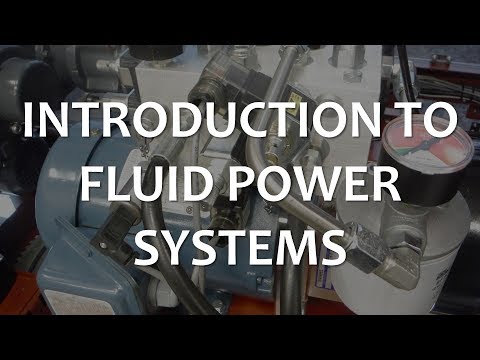1.1: Introduction to Fluid Power Systems
- Page ID
- 3634
Describe the purpose of a fluid power system
Differentiate between fluid power systems and mechanical or electrical systems
Differentiate between hydraulic and pneumatic systems with respect to the fluid medium employed, characteristics, capacity, performance, and cleanliness
Describe a basic fluid power system in terms of power conversion.
Describe the role of a prime mover like a motor or internal combustion engine in a fluid power system.
Draw the schematic symbol for a motor and internal combustion engine.
Describe the role of a pump in a fluid power system. Draw the schematic symbol for a pump and reservoir.
Describe what properties pressure, flow rate, and valve position influence in a fluid power system.
Describe Pascal’s Law and the formula used to relate force, pressure, and area.
Describe the role of an actuator in a fluid power system. Draw the schematic symbol for a cylinder and hydraulic motor.
Comment on the drawbacks of systems composed of numerous stages
Comment on the advantages and disadvantages of fluid power systems
Identify safety concerns associated with fluid power systems.
Comment on sources of inefficiency within a fluid power system
Identify five different types of pressure control valves
Draw the schematic symbol for a pressure gauge, pressure switch, and pressure transducer
List the devices that control flow rate
Draw the schematic symbol for a flow control valve and comment on how they are employed in fluid power systems.
Draw the schematic symbol for flow meters and comment on how they are employed in fluid power systems.
Draw the schematic symbol for a check valve. Differentiate between free flow and blocked direction.
Describe the purpose of a directional control valve in a fluid power system.
Draw the schematic symbol for a 3 position, spring centered, manually actuated directional control valve with a closed center, a straight through position, and a cross connect position
Discuss how the above valve’s position influences a double acting cylinder’s actuation direction when the cap end port is hooked to actuator port A and rod end port is hooked to actuator port B.
Discuss how the above valve’s position influences a double acting cylinder’s actuation direction when the actuator ports are swapped (rod end port is hooked to actuator port A and cap end port is hooked to actuator port B).
Discuss how a double acting cylinder’s actuation direction is influenced when one port is blocked.
Describe the purpose of mechanical limit switches, magnetic proximity switches, and position transducers in a fluid power system.
Differentiate between energy and power and give examples of common energy and power units.
Determine the energy requirement in ft*lbf to move a 500lbf object 12ft.
Determine the power requirement in ft*lbf/s, hp, and W to move a 500lbf object 12ft in 2.3s.
Given a 72% efficient system determine the input power in W necessary to produce 5.6hp output
Given a 79% efficient system determine the output power in hp if 3.2kW was input



